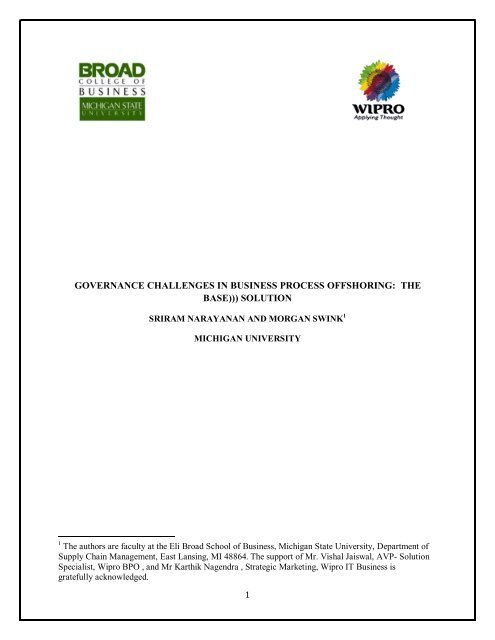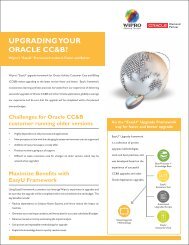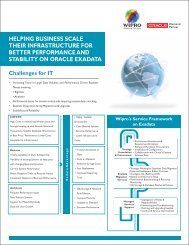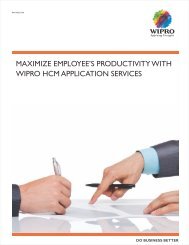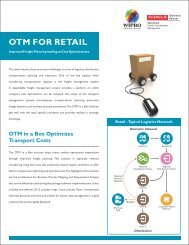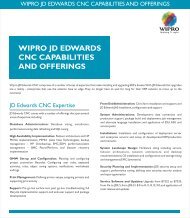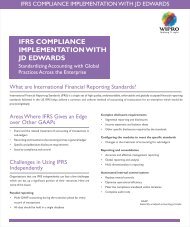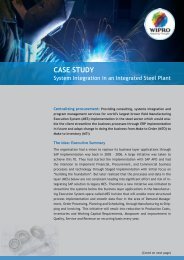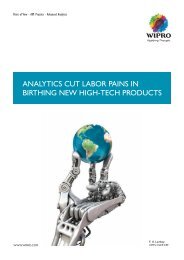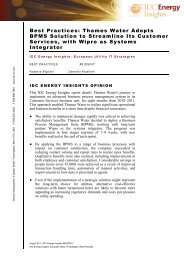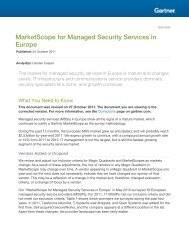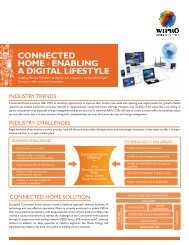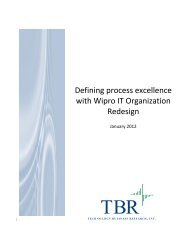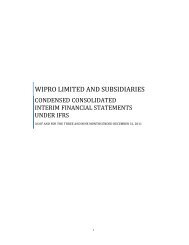GOVERNANCE CHALLENGES IN BUSINESS PROCESS - Wipro
GOVERNANCE CHALLENGES IN BUSINESS PROCESS - Wipro
GOVERNANCE CHALLENGES IN BUSINESS PROCESS - Wipro
Create successful ePaper yourself
Turn your PDF publications into a flip-book with our unique Google optimized e-Paper software.
<strong>GOVERNANCE</strong> <strong>CHALLENGES</strong> <strong>IN</strong> BUS<strong>IN</strong>ESS <strong>PROCESS</strong> OFFSHOR<strong>IN</strong>G: THE<br />
BASE))) SOLUTION<br />
SRIRAM NARAYANAN AND MORGAN SW<strong>IN</strong>K 1<br />
MICHIGAN UNIVERSITY<br />
1 The authors are faculty at the Eli Broad School of Business, Michigan State University, Department of<br />
Supply Chain Management, East Lansing, MI 48864. The support of Mr. Vishal Jaiswal, AVP- Solution<br />
Specialist, <strong>Wipro</strong> BPO , and Mr Karthik Nagendra , Strategic Marketing, <strong>Wipro</strong> IT Business is<br />
gratefully acknowledged.<br />
1
A CHALLENGE AND AN OPPORTUNITY<br />
Gary Kirsten, CFO of ABC Inc. a large Fortune 500 firm, noted that it was 6:00 PM as he<br />
looked out the 60 th floor window of his Manhattan office. Management of ABC Inc. had<br />
recently given centralized control to Gary for many of the firm’s Finance and Accounting (F&A)<br />
processes. The management had entrusted Gary with the daunting task of aggressive cost cutting.<br />
Specifically, his target was 30%. Gary’s firm was under tremendous pressure to cut its costs<br />
quickly and drastically. With ABC’s margins hovering around 3-4%, the CEO believed that<br />
cutting cost in support processes such as F&A was an important goal.<br />
Gary wanted to go beyond just cutting costs; he expected F&A processes to add more<br />
value and improve the firm’s “bottom line.” In particular, Gary believed that several aspects of<br />
the F&A processes could be exploited to make them “revenue generating” rather than simply<br />
being a “cost head” to the firm. Gary was also not very happy with the current information<br />
collection mechanisms used on F&A processes. Management was not willing to put in the<br />
investments required to significantly improve process monitoring. Consequently, Gary<br />
considered outsourcing to be a potentially attractive option.<br />
Many other firms seemed to be offshoring F&A processes in order to cut costs, but Gary<br />
wasn’t so sure about the effectiveness of outsourcing to low cost countries. He knew that the<br />
CFO of another firm, XYZ Inc., was in a similar situation two years ago. XYZ spent almost<br />
75% of their sales on items procured from vendors. Like ABC Inc., XYZ also had tight operating<br />
margins and competition was stiff. As a result, invoice processing significantly affected the<br />
firms’ profitability as payment at the right time enabled XYZ to gain discounts from suppliers.<br />
When XYZ outsourced its accounts payable (AP) process they found that their lack of ability to<br />
monitor payments caused “profit leakage” due to invoices not processed on time. In addition,<br />
large payments often impacted cash flows. Gary knew that XYZ managers often worried about<br />
their lack of visibility and inability to directly manage cash flows. XYZ’s overall experience<br />
with their vendor had not been good. In fact, it bordered upon being disastrous. The problems<br />
had started when XYZ began transferring their accounts payable (AP) process offshore. The AP<br />
process of XYZ involved several disparate systems that were built over time and would not<br />
“talk” to each other, including multiple ERP systems for various plants. Such disparate systems<br />
delayed the transition and made standardization difficult. Offshoring the processes had actually<br />
increased overall costs by 10% because of the coordination costs involved.<br />
Gary believed that ABC’s systems were even more complex than XYZ’s. Indeed,<br />
conflicts among IT systems at ABC had created huge barriers to his plan to implement a more<br />
efficient, unified AP process. Gary believed that a unified process would benefit the firm in<br />
multiple ways. First, the legal environment surrounding invoice processing required monitoring<br />
the history and compliance of each invoice. This was complex given the current IT<br />
infrastructure. Gary knew that managers at XYZ had spent a tremendous amount of time<br />
managing their supplier to verify whether it was complying with process requirements and<br />
2
providing targeted service levels. Gary hoped that his staff could spend less time on transactional<br />
tasks and more time thinking of value adding activities that might better “extract” profit from the<br />
AP process.<br />
While Gary was wary of the experiences of XYZ Inc., he still held out hopes that<br />
outsourcing might help ABC. He had recently read a series of press reports asserting that vendors<br />
had become better in managing these processes, and that transaction process outsourcing was<br />
growing at a fast pace. For example, leading market research firms suggested that the global<br />
Business Process Outsourcing (BPO) industry on HR related activities was estimated to grow<br />
from $28.1 billion in 2007 to $ 42.9 billion in 2012 (Gartner 2008). 2 Similarly the Finance and<br />
Accounting (F&A) BPO industry was estimated to grow from $12 billion to $ 19 billion in 2012<br />
at a CAGR of 12%. 3 Further, market research firms suggested that transaction processes such as<br />
the Finance and Accounting (F&A) and Human Resource (HR) processes had been a source of<br />
immediate cost reduction and quick payback for these firms, often as low as 3 to 6 months. This<br />
sounded like music to Gary’s ears. At the same time, he figured that achieving such results<br />
might be difficult given ABC’s particular challenges.<br />
Gary stared at a proposal from <strong>Wipro</strong> Technologies, a leading BPO company in India.<br />
Several of his managers had been in touch with <strong>Wipro</strong> and they had suggested outsourcing all of<br />
the company’s accounts payables processes to them. Gary thought that offshoring might give<br />
him the kind of cost savings his CEO was demanding. Before committing to such a course of<br />
action, however, he knew that he would have to feel much more secure about the vendor’s ability<br />
to manage the migration and ultimate execution of the process.<br />
ABOUT WIPRO TECHNOLOGIES<br />
<strong>Wipro</strong> is the first PCMM Level 5 and SEI CMMi Level 5 certified IT Services Company<br />
globally. <strong>Wipro</strong> provides comprehensive IT solutions and services (including systems<br />
integration, IS outsourcing, package implementation, software application development and<br />
maintenance) and Research & Development services (hardware and software design,<br />
development and implementation) to corporations globally.<br />
<strong>Wipro</strong>'s unique value proposition is further delivered through our pioneering Offshore<br />
Outsourcing Model and stringent Quality Processes of SEI and Six Sigma.<br />
BPO AND THE ACCOUNTS PAYABLE <strong>PROCESS</strong><br />
Gary had heard that many processes in domains such as Finance & Accounting and HR<br />
had been standardized by vendors using a “Lift and Shift” model. However, simply “lifting” and<br />
2 Gartner Report Number G00162336, November 25 2008<br />
3 Gartner Report Number G00162882, December 19 2008<br />
3
“shifting” the processes involved several nightmarish possibilities. In particular, Gary mentally<br />
tried to make a list of his key pain points. His core problems stemmed from the size and the wide<br />
disparity of processes located among the divisions within his organization. He thought that<br />
coordinating multiple processes from multiple divisions would be difficult for an outsourcing<br />
partner, given the complexities ABC had faced in managing the F&A processes within the firm<br />
itself. He wondered, “How can an external, foreign supplier manage the volumes of invoices<br />
from different business units?” As Gary began to feel overwhelmed at the prospect, he noted<br />
several problems that he expected to encounter when transferring the processes offshore:<br />
1. The nature of the AP process in itself was complex. Visibility into the process and<br />
monitoring it was important from a resource allocation standpoint. Each process (or<br />
transaction type) within the company had its own set of priorities. For example, some<br />
clients might need to have a different priority in payment as compared to others. Payments<br />
that had larger discounts needed to be processed quicker and faster as compared to payments<br />
that did not have discounting. This impacted the bottom line. These priority rules had to be<br />
accommodated for each process, thus creating queues of jobs that needed to be processed by<br />
employees (agents). . Agents varied in their expertise. Further, agents had to adopt priority<br />
rules based on attributes associated with the invoice. Enforcing these internal controls<br />
required a high level of visibility within the process and ABC often ran into resistance with<br />
divisions since the “experienced” agents often did not approve or prefer corporate<br />
interference. Gary felt that increased visibility of the processes allowed for a “single version<br />
of truth,” i.e. managers could rely on one source of information for all of their needs and<br />
contingencies. For example, to redress supplier grievances, management could easily find<br />
the required information to provide to the supplier in one simple step rather than wasting<br />
time to look around multiple places.<br />
2. In line with the complexity of the process, there had been growing concerns from ABC’s<br />
suppliers regarding invoice errors, and dissatisfaction with the time that ABC Inc. was<br />
taking to release payments. Some internal processes were poorly managed. However, Gary<br />
attributed many problems to the fact that various divisions had complete autonomy in<br />
decision making. The lack of centralized control caused lack of transparency in the AP<br />
process. Supplier grievances had risen 40%. In order to address these grievances, AP<br />
managers needed to maintain a clear audit trail. If a vendor queried or challenged a payment,<br />
then the relevant division was required to show a trail of the transaction history that could be<br />
used to verify the payment status. If any of the payment processes had exceptions, they had<br />
to be handled carefully and records of the exceptions maintained. Further, when exceptions<br />
became more common, division managers had to monitor and create different rules to<br />
govern a revised process. Therefore, identification and data collection on these “exceptions”<br />
was important. Given the multi-divisional structure of ABC, these exceptions were many.<br />
3. Monitoring was critical to other issues too. In particular, benchmarking and metrics<br />
programs could increase opportunities for cost savings in the future. Currently, ABC had<br />
4
poor metrics on internal processes within individual divisions. Part of the reason was low<br />
visibility into processes within the divisions. Gary was of the opinion that processes that<br />
could not be measured could not be improved. Attaining the highest level of visibility<br />
allowed ABC Inc. the opportunity to gain insights by mining AP data and improve the<br />
profitability. Gary strongly believed that his team should move beyond the current focus on<br />
cost reduction and move to process improvement and “revenue generation.” He believed that<br />
such a mindset would also raise the importance of effectively managing the AP processes<br />
within the firm.<br />
4. In addition to benchmarking and monitoring, Gary felt that the payment process was mired<br />
in red-tape. It typically involved multiple approval hierarchies based on invoice values.<br />
Gary’s division often saw such processes as a “necessary evil” since they were not the best<br />
use of his managers’ time. With increasing pressure to curtail costs, Gary believed that his<br />
division would be better served by investing their time on issues that were relevant to the<br />
bottom-line of the firm. Developing metrics and visibility into individual processes was the<br />
first step in reconfiguring how his managers spent their time. Transferring the current AP<br />
process offshore might potentially increase the number of times invoices would be handled<br />
due to the additional layer of staff and possibly increase his staff’s burden rather than reduce<br />
it.<br />
Gary wondered how outsourcing might amplify, and not destroy, the latent value embedded in<br />
the AP process. His problems were not just restricted to the finance division, but also the IT<br />
division. His meeting with the CIO of ABC Inc. the previous day had shed light on other<br />
problems that needed to be addressed:<br />
1. ABC Inc. used multiple invoice formats within the firm. Some divisions processed paper<br />
invoices, others used email invoices and yet others used traditional FAX and XML based<br />
electronic invoices. Often, these invoice formats were processed based on different business<br />
rules making reconciliation across the different procedures difficult. This resulted in many<br />
invoices not being appropriately processed, creating a considerable amount of financial loss<br />
apart from process complexity. Often the finance staff in XYZ had to make several phone<br />
calls to divisional personnel to clarify the different aspects of invoice processes.<br />
2. The variation in processes between the divisions caused “data within data” kind of scenarios.<br />
How could all this data be integrated into a single framework that provided visibility? Gary<br />
feared that outsourcing such multiple processes might create a huge hassle for his division,<br />
thus wiping out potential cost savings. He wondered what the costs of managing these<br />
processes would be, and whether service levels would truly improve.<br />
3. ABC Inc. operated multiple information systems in different locations, and faced significant<br />
challenges in standardizing these processes when they would outsource. Also, individual<br />
divisions had widely differing expectations on the service levels that they expected in<br />
5
processing the invoices. Gary spent a good deal of time on the phone interacting with his<br />
divisional Finance and Purchasing staff. Often they unable to agree upon a common process<br />
or service level for their respective divisions.<br />
4. Gary had to review multiple spread sheets each month, each crafted by division managers<br />
according to their specific needs. Gary’s calls for standardization had been ignored. Further,<br />
some of his staff tended to download the data onto their desktops from ERP systems, and<br />
then perform the analyses using standardized Excel templates. Often such analyses would be<br />
difficult to capture with the current systems. Partly this was because the current IT<br />
infrastructure within the firm was complex. Each of the functional groups in different<br />
business units had over time implemented different systems to manage different business<br />
processes. The current economic climate did now allow for the large investments required<br />
to unite the disparate systems<br />
5. Finally, data integrity was not what Gary wanted it to be. He had his doubts regarding the<br />
accuracy of data reported by the divisions. Indeed, data errors were a key source of supplier<br />
grievances.<br />
Gary wondered whether all of these problems and process complexities would make outsourcing<br />
of the AP process too costly. It was difficult to estimate how much management time would be<br />
needed to ensure adequate controls were in place, to verify audit trails, to mine data for business<br />
insights, to manage the supplier relationship, and to manage AP process exceptions. Would<br />
supplier governance cost be high enough to wipe out cost savings? Given that the transaction<br />
volumes ran into the millions and generated huge amounts of data, how could ABC coordinate<br />
their efforts with agents at the vendor? In particular, how would improvements to processes be<br />
identified and incorporated? The challenges of executing such a workflow from an offshore<br />
location seemed to be daunting. “No wonder XYZ Inc. suffered cost increases when they<br />
shipped their work offshore” Gary thought.<br />
Further, he thought that the contract itself might be quite complex. A massive<br />
outsourcing initiative “Might rob our company of visibility into processes,” Gary thought. He<br />
wasn’t sure if he could trust offshore delivery. XYZ Inc’s experience was that their offshore<br />
process had become a “black box” of sorts. Adding more resources to a “black box” was not<br />
really an option. Gary realized that a quick payback from offshoring would be difficult to<br />
achieve. If processes were managed offshore as a “black box,” the loss of transparency and<br />
control could end up consuming considerable resources of the firm. In addition, Gary’s firm<br />
would lose its ability to re-engineer the process. The prospect of millions of invoices getting lost<br />
in the service provider “black box” could hurt his business severely in the long run.<br />
BASE)))<br />
As Gary was getting more restless with his problems, his phone rang. Daman, one of<br />
WIPRO’s sales persons, was on the call. After listening to Gary’s concerns, Daman began<br />
6
describing a process execution and governance tool known as “Base)))”, engineered by WIPRO.<br />
Daman explained that Base))) could be an answer to a majority of Gary’s perplexing questions.<br />
A technology mediated governance model facilitated by the Base))) tool could enable them to<br />
quickly offshore some of the processes and facilitate greater transparency and a faster payback.<br />
The Base))) tool could facilitate coordination between ABC Inc. and the service provider – and<br />
within the various agents of the service provider – with the broad set of functionalities that the<br />
tool offered. Further, Daman suggested that Base))) could potentially solve his problems. Daman<br />
suggested that the Base))) tool provided benefits related to effectiveness, efficiency, compliance<br />
and governance.<br />
Daman went on to explain some important features of Base))). From an effectiveness<br />
standpoint, Base))) contained the ability to decouple the disparate systems in the organization<br />
with minimal set up. In particular, this decoupling enabled each organization to maintain its IT<br />
infrastructure in the division and manage to still bring together the possibility of gaining<br />
economies of scale of the processing that may happen in multiple divisions. The platform could<br />
accommodate different sets of processes, integrate the incoming data from multiple systems,<br />
present a single interface, manage the overall services and enable effective monitoring of the<br />
systems. Further, the system enabled the organization to access to a work flow platform that<br />
effectively managed the process, and allowed prioritization and integration of the different sets<br />
of processes from the various units of ABC Inc. These benefits addressed many of the limitations<br />
of ABC’s IT infrastructure.<br />
Gary thought that the Base))) could also contribute to improving the overall efficiency of<br />
the AP process. This was primarily the benefit of improved audit trails enabled by the tool. In<br />
particular, greater visibility and control enabled by the capturing the history of invoice<br />
transactions could enable process improvements, decrease turnaround times for invoices, and<br />
enable better monitoring of the invoices. The increased visibility could enable them to put<br />
together metrics and targets based on best in class performance across the divisions. Such<br />
metrics might include invoice backlogs, cash conversion cycle times, and on-time versus delayed<br />
payments. The visibility provided by Base))) could also promote efficiency in dealing with the<br />
numerous exceptions that occurred, thereby minimizing financial loss and improving supplier<br />
satisfaction. In addition, increased visibility could increase compliance to processes, service level<br />
agreements, and contract terms. Processes often involved approval protocols that were complex<br />
and multi-leveled depending on the nature and importance of the transaction.<br />
Finally, Gary realized that Base))) could give his company greater control over activities<br />
in the offshore environment with appropriate reporting structures that could be customized<br />
according to ABC’s needs. Information could be disbursed online through better availability of<br />
the standard operating procedures. In addition, the tool might also help better govern ABC’s own<br />
suppliers by monitoring vendor-wise performance metrics and SLA’s.<br />
7
Suddenly many of the Gary’s worries started to disappear as he started to think about all<br />
the different metrics that he could potentially collect from the tool. While Gary was still not<br />
convinced, he began to see how such a tool could help. He asked Daman to describe how the<br />
tool might be applied to an accounts payable process.<br />
EXAMPLE <strong>PROCESS</strong>: ACCOUNTS PAYABLE<br />
Daman used Figures 1a, 1b and 1c to illustrate how the Base))) interfaces with the overall<br />
workflow of an accounts payable process. The processes began at the client site when a paper<br />
invoice arrives and is scanned (Figure 1a). Base))) inputs scanned data in a batch mode with the<br />
help of a scheduler. Each batch of data could be collected and input in multiple chosen formats,<br />
thus enabling the software to integrate the data from various systems. Further, the workflow<br />
software creates internal work processes for each individual invoice that can be handled by the<br />
accounts processor. The processing agent goes through a sequence of steps shown in Figure 1a.<br />
Once the processes are entered into the workflow software, the reporting matrix enables sorting<br />
of typical workflow issues including validation of the invoice. This validation might often<br />
require setting up of the appropriate business rules, reporting and escalation across different<br />
levels of the organization in order to appropriately route the invoice payment approvals to the<br />
involved individuals.<br />
Upon validation, the payables processes would be managed appropriately. The work flow system<br />
creates queues of jobs for each process (Figure 1b). For example, each of the invoices in a queue<br />
would be routed to a handling agent who possesses the appropriate skill sets. Once in queue, the<br />
invoice would be monitored for processing quality; an audit trail of the process would be<br />
maintained to ensure verifiability of process history. This might include the history of the various<br />
reminders for the process, the escalations that may have happened in processing the invoice, and<br />
the interaction history of processing the invoice. This phase also requires a considerable<br />
monitoring of the service levels and data gathering that enables the computation of the service<br />
level and other measures of interest that can be used to compare against pre-defined agreements<br />
Base)) enabled collation of multiple measures related to the process across various levels. These<br />
measures are not limited to but may include:<br />
a) Governance of the process including:<br />
i. transaction backlog (actual transaction volume versus forecasted transaction<br />
volume - See Figure 2)<br />
ii. total transactions within the system<br />
iii. turnaround time (TAT) analysis (see a sample screen shot of the TAT feature in<br />
Figure 3)<br />
iv. quality of process execution in terms of the accuracy of transactions<br />
8
) Process metrics including:<br />
i. nature of exceptions<br />
ii. classification of exception transactions by vendor<br />
iii. other process reports such as age of the different transactions and their numbers<br />
iv. percentage of exceptions<br />
v. Invoice cycle times<br />
c) Business metrics such as:<br />
i. the number of invoices that are coming of age<br />
ii. the nature and type of discounting applicable to particular invoices.<br />
iii. cost per invoice<br />
Daman suggested that this example of the accounts payable process could be extrapolated<br />
to include multiple classes of metrics in each of the processes.<br />
BEYOND ACCOUNTS PAYABLE<br />
With many of his doubts resolved, Gary thought about the applicability of Base))) beyond<br />
the account payable process. For example, Gary could use the tool to coordinate other business<br />
related outcomes. For example, Gary thought that the metrics extracted from Base))) could be<br />
customized to his needs and he could potentially link process metrics to business outcomes such<br />
as cost reductions and other sales related metrics such as “Days payables Outstanding,” “Days<br />
Sales of Inventory” and other similar measures. Further, Gary wondered whether the tool would<br />
allow them to monitor metrics to implement six-sigma processes. These initiatives could make<br />
the processes considerably tighter and so they could establish service levels around the process<br />
and facilitate process improvements. Gary was reasonably sure that the Base))) could be<br />
customized for any kind of transaction processing for their firm.<br />
Gary then questioned Daman on the cost of implementing the tool. Daman explained,<br />
“The cost and implementation timelines for implementation of Base))) would vary depending on<br />
the number of processes for which Base))) is being implemented, the number of process users,<br />
the complexity of the processes and the type of interface requirements between Base))) and<br />
existing systems of the client.” Daman explained that he needed to develop quotes for individual<br />
processes. He went on to talk about the “4D Process” of implementing Base))) shown in Figure<br />
4. Further, Gary learnt that these tools also required a post deployment support provided by<br />
9
WIPRO throughout the contract duration. A more detailed assessment would require Gary’s<br />
company to request for an RFP.<br />
CONCLUSION<br />
This case illustrates some of the key governance and process challenges that an organization can<br />
face when offshoring processes in general, and how technology can serve as an effective medium<br />
to tackle these challenges. The illustration of the accounts payable process shows how<br />
technology can be of considerable assistance in the governance and monitoring of offshore<br />
relationships, particularly when the appropriate measurement processes across different business<br />
levels can be put in place. Individual users of a tool such as Base))) need to judge the cost<br />
efficacy and understand the returns on the tool depending on the nature of the process, level of<br />
customization and their process related objectives.<br />
10
FIGURE 1A: THE ACCOUNTS PAYABLE <strong>PROCESS</strong><br />
FIGURE 1B: THE ACCOUNTS PAYABLE <strong>PROCESS</strong><br />
11
FIGURE 1C: THE ACCOUNTS PAYABLE <strong>PROCESS</strong><br />
FIGURE 2: A SAMPLE REPORT ON <strong>IN</strong>COM<strong>IN</strong>G TASK VOLUME<br />
12
FIGURE 3: A SAMPLE MEASUREMENT REPORT ON TRANSACTION<br />
TURNAROUND TIME<br />
FIGURE 4: PHASES OF BASE))) IMPLEMENTATION<br />
13


